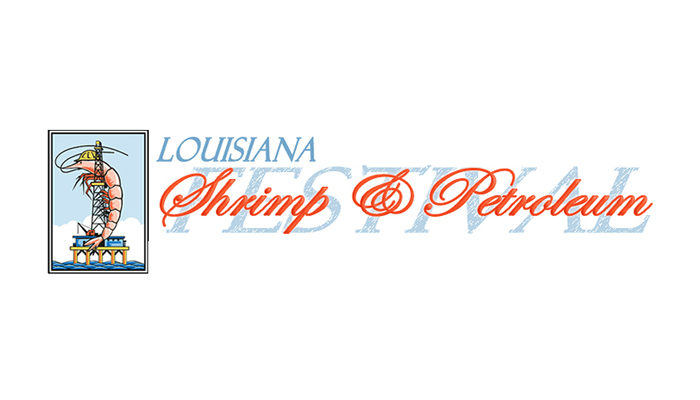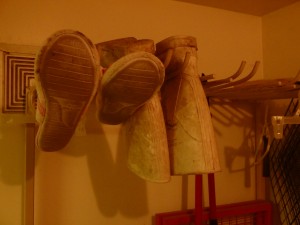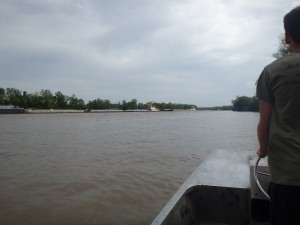http://ramblingfisherman.com/img_4954/  Randy and I had contacted Dean Wilson, the legendary founder of the Atchafalaya Basinkeeper, to arrange a tour of the area. Wilson is a member of one of the most exclusive clubs in the world, the Louisiana environmentalists. Conditions in Louisiana do not tend to generate environmentalists. Not only is the state, which is one of the reddest of all red states, fundamentally committed to extraction industries, but the tropical abundance creates a sense of infinite permissibility for infinite abuse. Things grow back; animals return; the whole thing seems inexhaustible. I had expected to find a dead zone out in the Gulf and instead I found porpoises and pelicans and pogiefish; this was a place you could abuse and abuse and abuse and still find living and willing later.
Randy and I had contacted Dean Wilson, the legendary founder of the Atchafalaya Basinkeeper, to arrange a tour of the area. Wilson is a member of one of the most exclusive clubs in the world, the Louisiana environmentalists. Conditions in Louisiana do not tend to generate environmentalists. Not only is the state, which is one of the reddest of all red states, fundamentally committed to extraction industries, but the tropical abundance creates a sense of infinite permissibility for infinite abuse. Things grow back; animals return; the whole thing seems inexhaustible. I had expected to find a dead zone out in the Gulf and instead I found porpoises and pelicans and pogiefish; this was a place you could abuse and abuse and abuse and still find living and willing later.
http://thehistoryhacker.com/2013/08/14/the-civil-war-a-lecture-part-one/?replytocom=948 Or so it appears on the outside. What I saw in the Atchafalaya gave me a sense of the tremendous problems southern Louisiana faces after centuries of environmental indifference.
The positives, however, cannot be overlooked. The Atchafalaya is in many ways an example of what could be. It is enclosed by levees, but whereas the Mississippi levees begin at river’s edge and limit the river’s width to something under two miles, the Atchafalaya is twenty miles wide, a wonderland of swamp in its upper reaches and marsh by the coast, filled with fish and birds and raccoons and alligators, and even bears and panthers. It is the single most significant wild area at the base of the Mississippi Flyway, one of the continent’s great corridors for migratory birds; because it receives a substantial percentage of the Mississippi’s water, it is almost the only wetland area in southern Louisiana whose existence is not fundamentally threatened. In fact, it is growing: the swamps are silting up, marsh is becoming swamp, and open water by the Gulf is becoming marsh.
But this growth is, in itself, something of a problem. Thirty percent of the Mississippi’s water, even spread out over twenty miles, is an incredible amount of water and sediment. The existing ecosystems are shifting rapidly. Swamps are forests whereas marshlands are grass, but it takes decades for forests to pioneer new territory. The Atchafalaya is hence gaining soil depth but losing forest cover, not least because of the fact that most of its land is in private hands and is logged.
Randy and I drove through Morgan City on our way, one of the chief cities of the Cajuns. It is the home of the Louisiana Shrimp and Petroleum Festival – an event which seems to sum up the contradictions of this part of the world fairly well. An image of a shrimp wrapped around an oil rig greeted us as we drove into town.
“Morgan City has a kind of strange relationship with the Corps,” Randy said. “It’s a city of about ten thousand people. New Orleans, including the metro area, is over a million. Part of our official protocol in dealing with a major flood on the Mississippi is that we will open up the Morganza Spillway, which is one of the structures connecting the Mississippi and Atchafalaya. In essence, if things get too hot for New Orleans, official policy is that we’ll just send the water to Morgan City. Morgan City is right in the middle of the Atchafalaya – on an island right at the mouth of the river. And its levees are nowhere near as high as those in New Orleans. And in particular the levees facing the Atchafalaya are pretty weak. We opened the Morganza Spillway in 2011, and the Atchafalaya was able to handle the water, but still it was touch and go. If we had more water come down when we opened it that would have been the end of Morgan City. And of course if the Old River Control Structures keeping the Mississippi from the Atchafalaya ever fail, Morgan City will get completely destroyed for sure.”
“On the other hand,” I said, “if the Old River Control Structure weren’t there, Morgan City would be gone already.”
“For sure. We almost lost control of the river in the flood in 1973 – the Old River Control Structure very nearly failed and collapsed. If that had happened, we’d be floating in the middle of the Mississippi right now.”
McPhee writes about that event – he says that a camera was put down into the water by the dam to inspect the foundations under the water. All the camera saw was fish. The foundations were almost completely gone. The Corps poured everything it had into the breach to save it for the time being, and then build a new structure.
We came into Bayou Sorrel, where we were meeting Dean Wilson’s son. We met at a little convenience store, where I stopped in to use the bathroom. In the bathroom two pairs of white rubber boots – Coonass Reeboks – hung on a rack. Over the toilet was a sign: DO NOT THROW TAMPONS, PAPER TOWELS, OR TOILET PAPER IN TOILET PLEASE PUT IN TRASH CAN!!! Someone wrote over this: “What about a Pigeonite without his white rubber boots and a 12pk of Natural Light under his arm?” A Pigeonite is a Cajun from nearby Bayou Pigeon. None of the Cajuns are known for their good taste in beer.
Behind the counter was a pretty young brunette, who looked like she could dance the fastest zydeco numbers around; the liveliness of these people is always amazing to me, sweltering in their tropical heat.
The young Mr. Wilson was in place. He was dark-haired and wiry, a bit more angular than the average Cajun, and still in college, studying ecology and environmental science . Like so many in Louisiana he did not seem to have any problems about following in his father’s footsteps: he was proud to be doing what his father did, though he acknowledged he had a ways to go before he could equal his father’s knowledge. “I’m sorry he couldn’t take you out himself. He really knows the stuff like you can’t believe. But I’ll do my best.”
He led us over to the boat launch where we boarded a little pirogue, he fired it up and off we went. At first we followed one of the main channels of the Atchafalaya, whose water was high – springtime – and with a good current. This channel is part of the intracoastal waterway, an inland water route allowing boats to move up and down the coast without ever entering open ocean. Boats heading west come up the Mississippi and then come through a canal to the Atchafalaya. We saw typical river traffic here, including a large number of barges. We then pulled off the main channel and plunged into the swamp.


Post a Comment